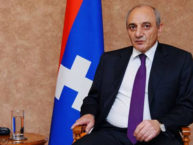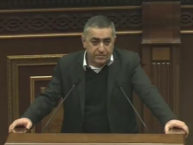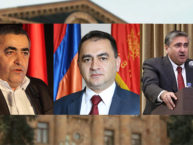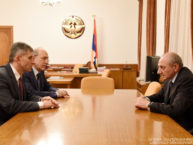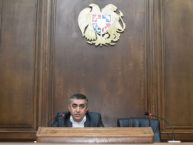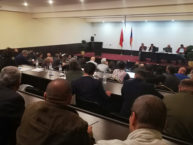By Andy Turpin
Armenian Weekly On-Line,
Volume 73, Number 15, April 14, 2007
 CAMBRIDGE, Mass. (A.W.)–On March 31, less than a year after the highly successful Armenians and the Left (AATL) conference in New York, scores of activists, students and intellectuals from across the Northeast converged at Harvard University for a one-day symposium organized by AATL. Co-sponsored by Harvard’s Center for Middle Eastern Studies, the symposium featured leading Armenian journalists and media critics, groundbreaking environmental activists working in Armenia today, and outspoken proponents of meaningful Armeno-Turkish dialogue.
CAMBRIDGE, Mass. (A.W.)–On March 31, less than a year after the highly successful Armenians and the Left (AATL) conference in New York, scores of activists, students and intellectuals from across the Northeast converged at Harvard University for a one-day symposium organized by AATL. Co-sponsored by Harvard’s Center for Middle Eastern Studies, the symposium featured leading Armenian journalists and media critics, groundbreaking environmental activists working in Armenia today, and outspoken proponents of meaningful Armeno-Turkish dialogue.
The panelists criticized the ruling elites–oligarchs and plutocrats–in Armenia, whose complicity in perpetuating endemic corruption has created enormous inequality and has placed Armenia’s very sustainability at risk. They also took aim at the Turkish state which has created an environment of impunity for vigilantism, as was recently seen in the assassination of the Istanbul based Armenian journalist and human rights activist, Hrant Dink. Members of the audience engaged in active dialogue during lively and heated question and answer sessions, which were often as substantial as the presentations themselves.
Conceived by the ARF-Dashnaktsutyun USA-Eastern Region, the series of public forums and conferences organized under Armenians and the Left strive to present Armenian issues in a global, progressive context. They are meant to appeal to all those–Armenian and non-Armenian–who have an activist mindset and an appreciation for what binds the various plight of dispossessed groups, and are alarmed at the menacing trends that are threatening the world and its people.
Panel I: Oligarchs, Social Injustices and Media in Armenia

A panel on “Media and Social Injustice in Armenia,” moderated by Antranig Kasbarian, featured Armenia’s foremost investigative journalist Edik Baghdasaryan of Hetq (www.hetq.am), Khatchig Mouradian of the Armenian Weekly, professor Gayane Torosyan of the State University of New York and Steve Kurkjian of the Boston Globe as discussant.
Dr. Gayane Torosyan, assistant professor in the Department of Communication Arts at the State University of New York-Oneonta, spoke first.” The so-called public sphere in Armenia is strongly dominated by various political parties and interest groups instead of being a truly public place for societal discourse, she said.
Torosyan said that a major factor was the monopolization of the media industry by businesses. “Instead of paying for advertising on TV, radio or newspapers, the most successful businesses choose to buy, bribe or influence those media in bulk to turn them into their mouthpieces.”
A successful Armenian businessman, she continued, could buy the entire Armenian media several times over for much less money than the cost of a Super-Bowl ad.
Torosyan quoted a recent report issued by the European Journalism Center in the Netherlands that assessed the plight of Armenian journalists; it said “that the biggest enemy of journalists in Armenia is the lowering of professional standards.” She added, “The public trust towards media is hard to gain and easy to lose, with that trust vanishing day by day.”
Torosyan then explained how journalism has been forced to transition and evolve since the fall of Soviet Union, primarily through professional method trainings exported from the U.S. and Europe. “The core of that transition of the new practices was the concept of objectivity,” she said, adding that it can be difficult to break the cultural trends that are still ingrained from the Soviet period. She quipped, “Is Armenian media democratic? In principle, yes, but the notion of objectivity should be viewed as the cornerstone of interventions into post-Communist media.”
She explained that some, bolder Armenian journalists are trying to enact the Western style and act as watchdogs, but that there is fear of retaliation. “The shyer ones are simply respecting authority and using that as their hindrance,” she said. “The low self-esteem among Armenian journalists can only be cured with assertively, honesty, patience to avoid selling themselves to the highest bidder, and finally becoming an institution on their own.”
Khatchig Mouradian, editor of the Armenian Weekly and former editor of the Lebanese-Armenian newspaper Aztag Daily, spoke next. He prefaced his remarks, titled “Free, But Not Independent,” by sharing an anecdote about negligent writers in Armenia once publicizing Peter Balakian’s acclaimed book The Burning Tigris, as the misnomer The Burning Tigress. “I wanted to give this example to follow up on the professor’s remarks on being thorough when dealing with news reports, trying to be objective, and gathering as much information as possible,” he explained. “Or at least trying to deal with the information in a decent way.”
During the Soviet period, he said, “There was a lack of interest for empirical truth and definitely no space whatsoever for investigative journalism. In the 80s and early 90s, however, we always speak about the Golden Age of Armenian journalism and media. This has been reflected also in other countries of the former Soviet bloc.”
Yet, what contributed to the media’s decline soon after independence was the gradual inability of the newspapers, radio and TV stations to sustain themselves. “They first came under the influence of the state, and eventually the influence of the state and oligarchs.”
“The real investigative journalists in Armenia are the readers,” he said, “[who] realize that they can’t trust the media and that what they have to do is read different sources of information and to try to come up with a conclusion” of what’s really going on.
Recounting a remark by another Armenian editor on the issue, Mouradian quoted him as saying, “The amount of money I receive for printing one article about a specific leader in Armenia is much more than actually increasing my subscribers by 200.”
“I don’t want to give the impression that the media is utterly controlled like in some totalitarian countries,” he clarified. “The main problem is that different forms of pressure exist and there are different ways of self-censorship for personal gain.”
He characterized the underlying problem among Armenian journalists. “They’re free to say anything, but they’re not independent and they’re definitely not socially responsible. For them, being free is being free of moral obligation and social responsibility.”
Making a quick comparison with Diasporan newspapers, Mouradian noted that they “are controlled by political parties, churches and cultural organizations. There is very little criticism and a lot of collective silence.”
He then discussed the options for countering these trends, pointing to blogs and online publications like Hetq for inspiration. “There has been an increasing number of blogs dealing with social, political and economic issues in Armenia. They create this very essential small space where people can interact, get information, news, and give insight that is not sponsored by this or that leader. … These can provide readers with alternatives.”
The final speaker of the panel was veteran Armenian journalist Edik Baghdasaryan, editor of HETQ Online and head of the Investigative Journalists of Armenia NGO.
Panel moderator Antranig Kasbarian translated his remarks from Armenian to English.
Baghdasaryan opened by saying, “The current circulation of Armenian newspapers is 40,000; meanwhile the population of Armenia is said to be three million. There’s a disconnect here.” He continued, “Ninety-five percent of these newspapers are circulated in the Yerevan environs. This means that essentially hundreds of villages outside of Yerevan and inKarabakh, have not seen a newspaper in years.”
Baghdasaryan said that the majority of Armenians rely on TV for their news and information. “The public television station is viewed essentially as the property of the President of the Republic of Armenia,” he added. “According to those news reports, everything in Armenia is just fine. Based on the facts from those channels, every day new factories are opening, every day presidents of other countries come and go, and every day there are new concerts.”
He said that this purveyance of a distorted reality was greatly affecting the well-being and morale of the Armenian people. “In this programming, no Armenians are shown to exist outside of Yerevan. People feel isolated outside of Yerevan. They despair. They feel no one addresses even their existence.”
He clarified, “This phenomenon applies to TV as well as newspapers. The people of Armenia are found in an information blockade.”
Baghdasaryan said that the TV media in Armenia are under the supervision of the government. “There are private owners, but they purchase these networks at the behest of the government. The supervision of TV media often becomes a detailed affair. The presidential apparatus or administration will manage and micromanage who gets interviewed in the government, and how much time and space will be given to opposition voices.”
He shared why this is reflective of a more dangerous, “more painful” cultural trend, against those who speak out with different views. “The media is gradually losing its influence within Armenia,” he said. “In the United States, every so often a scandal will come out in the media and it will force people to resign from their positions amidst scandal. Unfortunately in Armenia these sorts of publications have no effect whatsoever.”
He challenged journalists and citizens to speak out with hard facts and follow through. “The papers are constantly talking in general terms about corruption in Armenia. But they don’t speak with specific forms of evidence. The problem is that when you start introducing certain forms of evidence, the state prosecutor’s office is obliged to act on it.” And so far, it has been unwilling to do so.
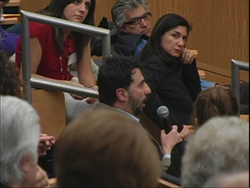 A very dynamic question and answer session followed. Baghdasaryan expressed enormous disappointment with the recent, large-scale investment of the Armenian-American Gerard Cafesjian in Armenia’s media sector, decrying how the extremely banal nature of his programming without any role for monitoring Armenia’s centers of power was only reinforcing the decaying influence of the press and the growing apathy of the Armenian public. Answering a question by the Armenian Mirror-Spectator, Baghdasaryan said, “No one has done more damage to the media [in Armenia] than Gerard Cafesjian. You have to see his broadcasts to understand [what I am talking about].”
A very dynamic question and answer session followed. Baghdasaryan expressed enormous disappointment with the recent, large-scale investment of the Armenian-American Gerard Cafesjian in Armenia’s media sector, decrying how the extremely banal nature of his programming without any role for monitoring Armenia’s centers of power was only reinforcing the decaying influence of the press and the growing apathy of the Armenian public. Answering a question by the Armenian Mirror-Spectator, Baghdasaryan said, “No one has done more damage to the media [in Armenia] than Gerard Cafesjian. You have to see his broadcasts to understand [what I am talking about].”
Baghdasaryan also talked, with examples, about the importance of Diaspora pressure in the fight against corruption. Following up on this comment, Mouradian noted that Diasporan Armenians are actively involved in e-mail campaigns to obtain genocide recognition or to try and influence Turkey to democratize, respect human rights and the rights of minorities, etc., but they rarely engaged in similar actions to democratize and fight corruption in Armenia. He stressed the need for a coordinated effort to assist Armenia not only financially but in becoming more democratic at the same time.
Panel II: Environmental Politics and Energy Needs

A panel on the fragile state of Armenia’s environmental conditions and energy needs, titled “Environmental Politics in Armenia” and moderated by Jeff Masarjian, featured president of Armenian Forests NGO Jeffrey Tufenkian, nuclear power industry expert Robert Kalantari, and founding director of Armenian Environmental Network Ursula Kazarian.
Jeffrey Tufenkian, president of the Armenian Forests NGO, spoke about the environmental zero-hour that Armenia is in right now.
“It feels kind of like we have our finger in the dyke. There are huge problems coming from every corner of the environmental front in Armenia,” he said.
Describing the republic’s lack of facilities, he said, “Besides deforestation and desertification we have solid waste issues. There’s not one proper solid waste disposal facility in the whole country. Trash is being burned openly. Sewage waste, and to some degree toxic waste from industry, is going untreated into rivers and lakes. Again, there’s not one proper waste sewage treatment facility in the country.”
Tufenkian explained that these problems were no longer side effects of an energy crisis but the overt results of rampant corruption and slight of policy. “The current problem is based much more on a few wealthy oligarchs and other powerful people who are taking in trucks into the forest and taking out truckloads of trees. They’re hiring local people, but it’s a much more systematic illegal business operation.”
“That’s not to say they don’t have permits,” he continued. “They have permits for sanitary cutting, getting the dead trees out of the forest. But they’re taking that one permit for getting dead trees out of the forest and using it for these healthy valuable trees in multiple places.”
If you project at the current rates of destruction, in a few short years Armenia could be almost forestless, he said. “We see a lot of cutting and no new growth.”
Speaking about other qualities of life that were at stake in this tipping of the balance, he explained, “Deforestation is not just losing trees. This is home for precious biodiversity. Over half of the six thousand different plants and animals of the Caucasus region are in Armenia. …We lose the forest, we lose habitat.”
“We’re moving to Armenia becoming a desert. Over 80 percent of land surveyed is under desertification. Myself, I’ve seen scorpions and snakes in Yerevan. It’s literally a process you can see happening.”
Tufenkian praised the past victories of environmental NGOs but reasserted the need both for more environmental activism and stronger anti-corruption measures to combat a political leadership that has no accountability to the public and the ravages of those who seek to profit off the land.
He ended by saying of the upcoming May 12 elections, “One of the biggest reasons for someone to vote is so that somebody doesn’t steal their vote. There’s a huge problem with that kind of corruption.”
Robert Kalantari, an electrical engineer with 25 years experience in the nuclear industry, spoke about alternative energy solutions for Armenia with a succinct assessment of the current situation.
“Reliable electric power, as we all know, is vital to national security,” he said. “You need electric power to be a country. Metzamor [Armenia’s sole nuclear power plant] supplies 40 percent of Armenia’s power needs.”
He outlined the use of thermal energy produced from fossil fuels, which has a very negative environmental impact. “Burning oil has to be trucked in. That gets very expensive. You need lots of oil, thousands of gallons an hour.”
Given Armenia’s politics and budget, he said, this option was the least reliable, despite the recent pipelines in place from Russia and Iran. “When you pipe, you’re at the mercy of foreign governments. Right now we have one friendly government, Iran.”
He praised the low output/low risk but also high-cost option of wind power. “Armenia has the potential for wind farms. … [It] has actually completed the first wind farm in the Caucasus. It is in its early stages and it’s costly.”
Regarding solar power, he said that large amounts of sunlight, which are not always available in Armenia, are needed, and that solar panel production is toxic to workers, although it’s currently used primarily in Korea.
Geothermal energy is another option, Kalantari said. “Armenia should have some potential for geothermal. But we have to do further research on where to put these plants. …Funding has been provided, believe it or not, for the construction of a 150-megawatt geothermal plant in the Sunik Marz. Supposedly it will be completed by 2009.”
He appeared to be most in favor of maintaining or increasing Armenia’s use of nuclear power, due to its higher output and lower long-term cost ratio. He weighed the consequences of nuclear energy, beginning with the bad news. “Armenia is right now storing all their waste on site. Russia is not taking it right now. That’s a concern.”
Assuaging possible concerns about the presently used Metzamor plant, he said, “It is not a Chernobyl-style reactor, and I want to emphasize that. The Armenian reactor is not an RBMK, the one that exploded. It’s scheduled to be closed in 2016, that’s the end of a 30-year life.”
Kalantari defended the use of Metzamor as logical power source for the moment. “If you shut down Metzamor, it’s going to be a major blow to the country’s resistance [to the energy crisis]. … Metzamor must continue to operate until there’s an alternative, and we hope that alternative is in the near future. 2016 is around the corner.”
Kalantari ended his remarks with a stress on the use of all options. But he reiterated that decisions must be made on future polices. “Armenia needs to include all viable options for safe and reliable power. But you can’t build these plants overnight. Every option has pros and cons to be discussed. Cost would be a major issue, same with construction time.”
The final panelist to discuss environmental issues, specifically the role of activism, was Ursula Kazarian, director of the Armenian Environmental Network NGO.
She initiated her remarks by universalizing the issue of Armenia and the environment. “Armenia is not specific in environmental problems,” she said. “We can learn so much from other countries that have had similar issues and have done many things to improve their situation. And we do have a unique resource at our disposal in having the Diaspora. Most countries that have these problems don’t have such an active Diaspora, the human capital to make things better.”
She said the sectors in Armenia that need the most emphasis and support are public health, transparency and economic development. “The truth is, the environment is extremely and intricately connected to our everyday lives.”
Kazarian added, “When you read in a newspaper, for instance, that in Yerevan there is a large rainstorm and the next day a hundred people go to the hospital, that’s connected. Why? Because the pipes broke and the water was contaminated. People drank the water and got sick.”
Kazarian also praised the great potential for environmental activism in Armenia, provided ordinary people are given real information on how crucial the issues are to their well-being. She said, “Once they know that their water is contaminated, they get active. They don’t want to be sick.”
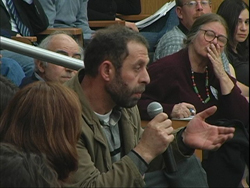 She concluded by suggesting low impact farming techniques and training initiatives that could be implemented in Armenia given enough grassroots and government support. “A lot of times we talk about economic development versus the environment. That doesn’t have to be the case.”
She concluded by suggesting low impact farming techniques and training initiatives that could be implemented in Armenia given enough grassroots and government support. “A lot of times we talk about economic development versus the environment. That doesn’t have to be the case.”
During the question and answer session, Edik Baghdasaryan noted that the environmental NGOs do not lobby political parties in Armenia, which is why none of the parties give any priority to environmental issues in their platform. The panelists acknowledged that fact.
Many questions also concerned Armenia’s energy needs and the situation with the Medzamor plant.
Panel III: Asymmetry of Power, Recognition Politics and Coalition Building
During the final plenary session, moderated by Dikran Kaligian, professors Peter Balakian of Colgate University, Halil Berktay of Sabanci University in Turkey and Henry Theriault of Worcester State College explored the controversy of how Armenians and Turks can honestly deal with the legacy of the Armenian Genocide and Turkey’s ongoing, violent campaign to deny it.

In tribute to Hrant Dink, a clip based on a poem titled “Letter to Hrant,” written by Khatchig Mouradian, was shown.
Henry Theriault, director of the Center for Human Rights at Worcester State College, spoke first about the under-discussed dynamics of Armenian-Turkish relations.
Professor Theriault opened by indicating that reconciliation cannot be the goal of Armeno-Turkish dialogue, as this presupposes a relationship that was once horizontal and equitable, whereas Turks up to the present have preserved a dominating one. Theriault also warned of allowing recognition of the Armenian Genocide to become primarily a means for reforming contemporary Turkish society. While that aim is important, he noted that it cannot supplant the more profound need for restitution and reparation for the victim group.
“There’s nothing that can ever make us, in my opinion, feel OK about the Armenian Genocide,” he said. “We can deal with it better, but it’s a part of history that we have to accept. That’s true from the Armenian and the Turkish perceptive.”
He continued, “It doesn’t mean they [Turks] can’t move forward, and it doesn’t mean there can’t be very positive social changes that make sure that it can’t happen again and that they begin to repair the damage to the relationship with Armenians, but it’s still going to be difficult. And I think that is as it should be. That’s part of what keeps us aware of how horrible genocide is. You can’t ever really get over it. There is no way to say I’m sorry, there is no way to resolve it.”
Theriault compared the assassination of Turkish-Armenian journalist Hrant Dink to that of American civil rights movement leaders. “We have to understand that he was not standing up to stand above Turkish society. He was standing up to be equal. To be treated as an equal human being, with the right to say what he wanted to say…”
Professor Theriault’s presentation focused on ways in which failure to recognize the power imbalance in the Turkish and Armenian relationship has undercut dialogue efforts while supporting the maintenance of a Turkish-over-Armenian dominance relation itself. Armeno-Turkish dialogue efforts over the past decade have taken various forms, from informal e-mail discussions to academic conferences. Yet, all have shared the same structural assumption: Armenian and Turkish participants, taken as representatives of their respective communities, are treated as equivalent parties in a balanced structure. Theriault stated that this assumption ignores the basic nature of the Armenian-Turkish relationship, which has been and remains a dominance relationship. He argued that meaningful positive change in Armeno-Turkish relations can occur only if the dominance issue takes a central focus.
“Armenians and Turks today exist in a dominance relationship,” he continued. He traced its roots to the long-held Ottoman millet system that placed Armenians as second-class citizens in the Ottoman Empire. “This gave way to a period of hyper-domination in the form of the Armenian Genocide, in which it wasn’t just control and power that were the issue, it was such a total domination of Armenians that it became eliminating Armenians from the land.”
The post-Genocide era, he said, has served to consolidate the hyper-domination hierarchy evidenced during the Genocide. “The Genocide has never been dealt with, which is maybe what the movement towards dialogue is about, to deal with how the Genocide transformed the Armenian-Turkish relationship.”
He noted that Turkey and Turks must stay conscious of their prejudicial attitudes of superiority over Armenians. “In genocides, when the killing ends, the dominance relationship does not end. …Many progressive Turks, even though they want a productive relationship with Armenians, still maintain a sense of superiority over Armenians.”
Theriault said that both camps must stay vigilant to not only foster good relations in the future but be aware of the relationship dynamics. “When the Armenian Genocide just becomes an issue that’s really about Turkish society [and its democratization] and not about the victims or the victim community, Armenians become instruments in another process. That’s a very dangerous path to go down.”
Peter Balakian, professor of humanities at Colgate University and author of The Burning Tigris, spoke next.
Balakian noted how much prevalence the Genocide has enjoyed in mainstream politics and media after so many years of being marginalized. “And yet, as a kind of leaping process has happened, there’s also been a violent backlash from forces inside Turkey. This has created a quandary, a conflict, and a problem to be solved or at least dealt with.”
Commenting on the murder of Hrant Dink, he said, “He was taking democratic society seriously, and for this he was murdered. He inhabited a delicate civic space in Turkey’s complex world.”
He then explained how power dynamics still motivate all aspects of the Genocide. “In the ongoing dialogue between Turks and Armenians, it seems important for Turks to acknowledge the issue of power, and how asymmetrical it was in 1915 and continues to be between our two cultures.”
“Armenians often felt, and do feel, trapped in a syndrome of reactiveness, because of the inherent asymmetry of power,” he continued. “Not to acknowledge this is to de-contextualize the history. I must say, I hope not to spend the rest of my life reacting to the mess of Turkish denial. I would even love to play golf someday.”
Regarding the Turkish government’s efforts to prevent passage of the Genocide resolution in the U.S., he said, “Congressmen have told me that in their several decades on Capitol Hill, they have never seen a foreign country come to our halls, our government to intervene or try to intervene on any issue as Turkey is doing now.”
He spoke about both communities moving, how “Armenians must always be seeking ways to heal and move forward and not get stuck in the rut of their rage or rigidity.” And, he said, “Armenians need to listen to Turks talk of their issues, their anxieties, their traumas and their different worldviews.”
Balakian ended on a note of universal and progressive solidarity among young Armenians and Turks, saying, “Armenians both in the Republic and in the Diaspora must divest themselves of stereotypes and essentialist notions about Turks and open themselves to the complexity of Turkish society. Only last week, more than a hundred students at Bogazici University in Istanbul staged a protest with the slogan ‘Against the Darkness’ and chanted Hrant Dink’s name and their solidarity with Armenians. These are forces that Armenians want to join with, if they can, and work with.”
Following the Balakian’s remarks, Halil Berktay, professor of history at Sabanci University in Istanbul and visiting scholar at Harvard University, spoke about his own experiences and perspectives on Armeno-Turkish relations.
He laid the groundwork for his analysis by giving his personal and ideological background. “I feel that since this is a panel and symposium called Armenians and the Left, it is part of my personal history that I seem to have belonged to the Left–or just a Turkish Left, but probably a more international kind of Left–from time immemorial,” he said. “My family history, from a very early age onwards, was one of persecution and suppression. I was four years old when my father was taken away in the Turkish fallout of the McCarthy era in the United States and spent some of my childhood years in prison.”
Berktay said that during the 1960s and 70s, beginning with his involvement in Yale University’s chapter of Students for a Democratic Society, he quickly became entranced in the anti-war movement, and following his return to Turkey in 1969, the militant Turkish Left movement.
Since then, his worldviews have become more moderate and analytical. “I have still retained certain notions of strategy and tactics for building alliances in pursuit of admittedly peaceful and democratic goals.”
“By talking to each other, talking about what our relative strengths and weaknesses might be,” he continued, “we can perhaps evolve a more comprehensive and sophisticated roadmap for removing that stone [the Turkish state’s denial]. … From this, we stand to gain a genuine emotional, mental recognition and therefore closure for Armenians all over the world. For Turks, this can mean a comprehensive and genuine democratization of Turkish society.”
Berktay attested that much of what he believes is contradictory to the opinions of Henry Theriault, and that as a Turkish historian who acknowledges the Genocide he would talk little about that historical reality and more about the “civil society politics” of recognition and obtaining recognition.
To make his views on the Genocide clear, Berktay spoke in great detail, saying, “If you want to pose the question, ‘Does it fit the existing, the available definitions of genocide?’ [my answer would be] of course it fits, and of course it is genocide. … Leave aside the massacres that then ensued, etc. Just by the deportation law and orders, because no discrimination was made as to whether these Armenians were Dashnaktsutiun supporters, whether they were involved in Hnchak activity or this or that, and no evidence was so defined or given, and because they were targeted as an entire ethno-confessional group, simply as Armenians, in terms of the 1948 Convention–even if there had been no deaths–this is tantamount to destroying the social, cultural mold social existence of an entire social group, or religion, or minority, or whatever you choose to call them.”
He talked about the formation of the Special Organization to implement the policies of genocide concocted by Talaat, Enver and Djemal Pasha, noting, “It is fairly clear that [the Genocide] happened as a result of two different sets of orders from Istanbul,” one for deportations, another for killings.
As a thorough historian he admitted, “Do we have direct proof of these secret orders? No, we do not. That is to say, we do not have a single telegram or two that we can point to as actually ordering state functionaries or operatives to slaughter this or that group of Armenians. But we do have an enormous amount of indirect evidence, of circumstantial evidence, so that in fact whether things that surface from illegality or extra legality, it is fairly clear what happened. We have something very close to a smoking gun, in terms of present American political idioms.” He deemed the massacres of 100,000 to 150,000 Mamara region Greeks by the Turks from 1913-14 as a “dress rehearsal” for the Armenian Genocide.
Berktay then chronicled the story of Turkish denialism and revisionist history regarding the Genocide. “One interesting aspect of late 20th, early 21st century Turkish nationalist denial is that its spokesmen or proponents have, it seems, stopped to read or forgotten about all the Turkish memoirs and media journalism accounts that were published in the 1920s and 1930s. In the 1930s, denialism did not exist. There was no question in Turkish society of the late 1920s and 1930s that Ottoman Armenians had by and large been uprooted, exterminated or annihilated. There were basically two opinions: Was this good or was this bad? But there was no question of this having happened. These sources are easily available today. They are not archival documents we’re talking about.”
Bringing home how Turkish society and denialism became so prevalent today in Turkey, Berktay recounted, “…With the national education apparatus and the media basically in the hands of the nation state, you can see how completely amnesia can develop over a generation or generation and a half. … On top of this, it was from the late 1960s and 1970s that a much more comprehensive denialist discourse was constructed and began to be systematically propagated. At least in some part related to the–at that time–assassination attempts on Turkish diplomats.”
Berktay described the status quo of the Turkish state, stating, “This denialist discourse became more and more established, absolute, proceeding way beyond its tactical objectives. After a point, I would like to suggest, the Turkish political class started comprehensively believing it. The more it was repeated the more it became a kind of national line with a political impossibility from breaking away from it.”
He continued, “Turkey’s biggest weakness is the enormous gap that has developed between domestic knowledge and world knowledge, which has enabled the establishment to constantly maintain that these are all baseless fabrications and slander being imposed on us from the outside. We have to keep struggling to inform and educate Turkish society. I don’t mean convincing every one of 80 million Turks that it was genocide, but at least we have to be able to democratize and normalize the conversation inside Turkish society.”
Berktay asserted that there were larger numbers of liberal and like-minded or dissent-minded Turks who need to be approached, saying, “Turkish society is big and therefore it is heterogeneous. It is enormously more heterogeneous than what most Armenians or Greeks realize from the outside. This is not just in terms of region differences but in terms of enormous educational and political differences.”
Lastly, he praised the Armenian Diaspora for producing copious amounts of literature and memoirs about the Genocide and advocated their continuance. But he warned, “Don’t take short cuts and reduce everything to the word genocide so that it becomes a buzz word and cliché that summarizes all the previous evidence but also substitutes for it so that it becomes too much of a cryptic short-hand to the uninitiated.”
(Sevag Arzoumanian and Doug Geogerian contributed to this report.)


